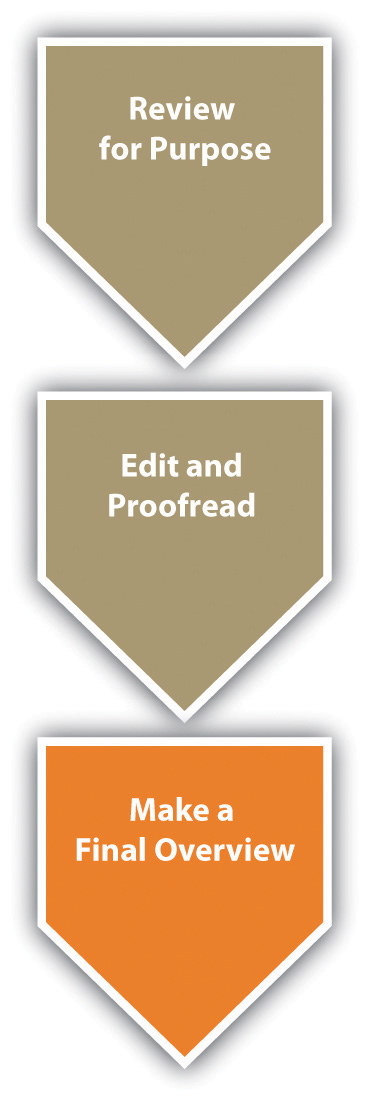This is “Making a Final Overview”, section 8.3 from the book Writers' Handbook (v. 1.0). For details on it (including licensing), click here.
For more information on the source of this book, or why it is available for free, please see the project's home page. You can browse or download additional books there. To download a .zip file containing this book to use offline, simply click here.
8.3 Making a Final Overview
Learning Objectives
- Understand the types of problems that might recur throughout your work.
- Know when you should conduct isolated checks during a final overview.
- Understand how to conduct isolated checks.
While you are managing the content of your essay and moving things around in it, you are likely to notice isolated issues that could recur throughout your work. To verify that these issues are satisfactorily dealt with from the beginning to the end of your essay, make a checklist of the issues as you go along. Conduct isolated checks of the whole paper after you are finished editing and proofreading. You might conduct some checks by flipping through the hard-copy pages, some by clicking through the pages on your computer, and some by conducting “computer findsA search for a certain word or phrase within text that is located on a computer.” (good for cases when you want to make sure you’ve used the same proper noun correctly and consistently). Remember to take advantage of all the editing features of the word processing program you’re using, such as spell check (described in more detail in Chapter 19 "Mechanics", Section 19.1 "Mastering Commonly Misspelled Words") and grammar check. In most versions of Word, for instance, you’ll see red squiggly lines underneath misspelled words and green squiggly lines underneath misuses of grammar. Right click on those underlined words to examine your options for revision.
Figure 8.3

The following checklist shows examples of the types of things that you might look for as you make a final passA personalized self-review of a final draft, focusing on making isolated checks of common areas of difficulty you’ve had as a writer in the past. (or final passes) through your paper. It often works best to make a separate pass for each issue because you are less likely to miss an issue and you will probably be able to make multiple, single-issue passes more quickly than you can make one multiple-issue pass.
- All subheadings are placed correctly (such as in the center or at the beginning of a page).
- All the text is the same size and font throughout.
- The page numbers are all formatted and appearing as intended.
- All image and picture captions are appearing correctly.
- All spellings of proper nouns have been corrected.
- The words “there” and “their” and “they’re” are spelled correctly. (Or you can insert your top recurring error here.)
- References are all included in the citation list.
- Within the citation list, references are all in a single, required format (no moving back and forth between Modern Language Association [MLA] and American Psychological Association [APA], for instance).
- All the formatting conventions for the final manuscript follow the style sheet assigned by the instructor (e.g., MLA, APA, Chicago Manual of Style [CMS], or other).
This isn’t intended to be an all-inclusive checklist. Rather, it simply gives you an idea of the types of things for which you might look as you conduct your final check. You should develop your unique list that might or might not include these same items.
Key Takeaways
- Often a good way to make sure you do not miss any details you want to change is to make a separate pass through your essay for each area of concern. You can conduct passes by flipping through hard copies, clicking through pages on a computer, or using the “find” feature on a computer.
- You should conduct a final overview with isolated checks after you are finished editing and proofreading the final draft.
- As you are writing, make a checklist of recurring isolated issues that you notice in your work. Use this list to conduct isolated checks on the final draft of your paper.
Exercise
Complete each sentence to create a logical item for a list to use for a final isolated check. Do not use any of the examples given in the text.
- All the subheadings are…
- The spacing between paragraphs…
- Each page includes…
- I have correctly spelled…
- The photos are all placed…
- The words in the flow charts and diagrams…




